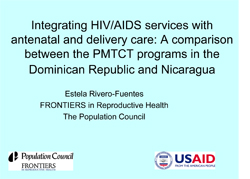Integrating HIV/AIDS Services with Antenatal and Delivery Care: A Comparison between the PMTCT Programs in the Dominican Republic and Nicaragua

Frontiers in Reproductive Health Program, Population Council
This research endeavour compares the experience, achievements, and obstacles to adequate implementation of the Population Council programme to prevent mother-to-child transmission (PMTCT) of HIV/AIDS - also called "vertical transmission" - in the Dominican Republic (DR) and Nicaragua. Summarised in this PowerPoint presentation from the International Conference on Actions to Strengthen Linkages between Sexual and Reproductive Health and HIV/AIDS in Mumbai, India (February 4-8 2007), the paper examines two different but complementary scenarios of the presence of HIV/AIDS and the organised response to this disease in Latin America.
Data from the United States Agency for International Development (USAID)-funded study are presented from a situational analysis of antenatal, delivery, and postpartum care and the PMTCT programmes conducted in each country. The methodology involved: analysis of written reports and interviews with key informants in the Ministry of Health (MOH) and non-governmental organisations (NGOs) that offer postpartum, post-abortion, and PMTCT services; analysis of the norms and official guidelines; structured and in-depth interviews with different groups of women; interviews with obstetrics-gynaecology directors, physicians, nurses, and other health providers; inventories of equipment, materials, supplies, and service statistics; non-participative observation of services; and focus groups with service users.
Results from the study show that both the DR and Nicaragua have succeeded at integrating voluntary counselling and testing (VCT) into antenatal and delivery care. They have achieved this integration in different contexts and through different interventions. In short, women in both places were found to receive the opportunity of VCT during pregnancy, independently of where they go for antenatal care (ANC). There is still a chance of catching those who did not receive the service early on - e.g., at the time of labour or delivery.
These programmes have not, however, been able to find a way to adequately integrate or link family planning (FP) and HIV/AIDS services so they can offer HIV-positive women the services they require. Both countries have taken actions to integrate FP services during antenatal and delivery care, but HIV-positive women do not benefit because, in both places, these women receive ANC and deliver in specific hospitals, by specific health providers, who do not provide FP services themselves and do not refer them elsewhere (except for some cases in the DR where female sterilisation is actively promoted). FP services outside of ANC, delivery, or postpartum (PP) care are not specific for HIV-positive women and are not included or linked to HIV care or treatment. Furthermore, researchers found that HIV/AIDS service providers tend to emphasise condom use and to discourage use of any other method. Thus, HIV-positive women who do not feel safe when using only the condom and wish to request an additional method may not find the information or referral guidance they seek. Rectifying this situation will require making sure that health providers understand the importance of integration, defining roles clearly (who is responsible for what?), and making sure that both sides understand and transmit the same messages.
- Log in to post comments
